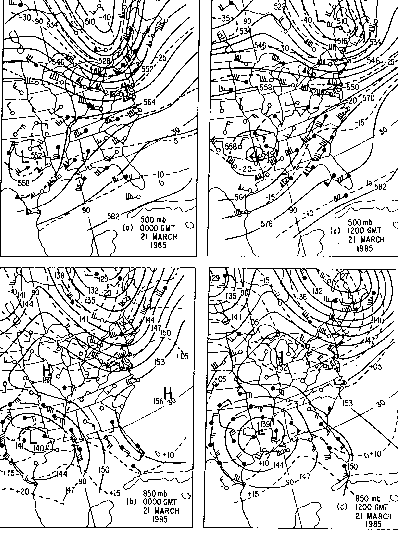NWS Birmingham, Alabama
Weather Forecast Office
Analysis and Comments on a March 1998 Wedge Event
Cold-air damming along the Atlantic coast has been well documented in a paper authored by Gerald Bell and Lance Bosart (1988). Based on a 50-year climatology of cold-air damming, they found that the events peak in the months of December and March. In March, a split flow pattern develops as the westerlies retreat northward. Northern stream anticyclones are displaced further northward, and instead of air damming up along the west side of the Appalachians, the cold air spills southward on the east side of the mountains. A slow moving southern stream upper low will cause surface pressure falls southwest of the pressure rises associated with anticyclone, resulting in enhanced southward transport of cold air. The figure below shows a typical 500 and 850 mb synoptic pattern during a March cold-air damming event (Bell and Bosart). The upper two maps contain the 500 mb analysis, 12 hours apart; while the lower maps contain the 850 mb analysis. Notice how the northern stream upper trough pivots rapidly eastward and becomes negatively tilted, while the closed upper low over the southern plains moves at a much slower pace.

| Page 1 | Page 2 | Page 3 | Page 4 | Page 5 | Page 6 |
Current Hazards
National Outlooks
Tropical
Local Storm Reports
Public Information Statement
Graphical Hazardous Weather Outlook
Current Conditions
Regional Weather Roundup
Rivers and Lakes
Drought Monitor
Forecasts
Fire Weather
Aviation Weather
Graphical Forecasts
Forecast Discussion
Air Quality
Climate and Past Weather
Past Events
Storm Data
Tornado Database
Daily Rainfall Plots
Tropical Cyclone Reports
Warnings and Other Products
Tornado Warnings
Severe Thunderstorm Warnings
Flash Flood Warnings
Winter Weather Warnings
Special Weather Statements
Non-Precipitation Warnings
Flood/River Flood Warnings
Productos en Español
Conciencia y Preparación
Previsión de 7 Días
Weather Safety
NOAA Weather Radio
Severe Weather Preparedness
Severe Safety Rules
Tornado Safety Rules
Severe Safety w/ ASL
Awareness Weeks
Severe Weather
Hurricane Preparedness
Summer Safety Campaign
Winter Weather
US Dept of Commerce
National Oceanic and Atmospheric Administration
National Weather Service
NWS Birmingham, Alabama
465 Weathervane Road
Calera, AL 35040
205-664-3010
Comments? Questions? Please Contact Us.

